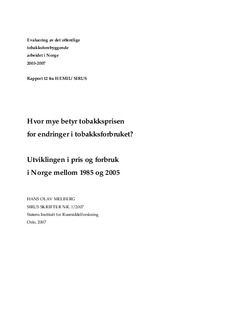| dc.contributor.author | Melberg, Hans Olav | |
| dc.date.accessioned | 2015-01-29T13:53:56Z | |
| dc.date.accessioned | 2015-02-11T18:41:15Z | |
| dc.date.available | 2015-01-29T13:53:56Z | |
| dc.date.available | 2015-02-11T18:41:15Z | |
| dc.date.issued | 2007 | |
| dc.identifier.citation | SIRUS-rapport. 29 p. Statens institutt for rusmiddelforskning, 2007 | |
| dc.identifier.isbn | 978-82-7171-296-9 | |
| dc.identifier.uri | http://hdl.handle.net/11250/275867 | |
| dc.description | - | |
| dc.description.abstract | Å øke prisen gjennom å pålegge høyere avgifter er ett av flere mulig virkemidler som brukes
for å redusere forbruket av tobakk. For å vurdere fordelene og ulempene ved et slikt tiltak,
trengs kunnskap om i hvor stor grad virkemiddelet har en effekt. Ved hjelp av statistiske
analyser av priser og salg av tobakk fra 1985 til 2005, kan man få noen svar på dette
spørsmålet. Analysen viser klart at effekten av innenlandske prisendringer blir redusert når
man tar hensyn til grensehandel, men reduksjonen er ikke så stor at de innenlandske prisene
blir uviktige. En 10% økning i de innenlandske prisene fører til en reduksjon i det totale
forbruket på omtrent 4,6% når man tar hensyn til grensehandel, mens effekten var omtrent
10% når man ikke tok hensyn til dette. Hovedkonklusjonen er dermed at en økning av de
innenlandske prisene virker svakere når man tar hensyn til grensehandelen, men effekten er
fremdeles stor nok til å være signifikant | |
| dc.description.abstract | Raising prices by increasing taxes on cigarettes and tobacco is one of the tools used to reduce
the consumption of tobacco. Given the importance attached to this tool, it is important to examine how well it works. Statistical analysis of the relationship between the price and sales of tobacco in Norway from 1985 to 2005 reveals the importance including a previously ignored variable: border trade and sales in tax-free shops. After including this in the analysis the effect of raising domestic prices was about half of what it was when border trade and taxfree sales were ignored. However, the reduction was not big enough to make domestic prices insignificant. The model suggests that a 10% increase in domestic prices leads to a reduction in consumption of about 4,6% after accounting for border trade, while the effect was about 10% when this was ignored. This leads to the conclusion that domestic prices still are important, but that the effect is substantially smaller when we include border trade and sales in tax-free shops in the analysis. | |
| dc.language.iso | nob | |
| dc.relation.uri | http://www.sirus.no/filestore/Import_vedlegg/SIRUSskrifter0107.pdf | |
| dc.title | Hvor mye betyr tobakksprisen for endringer i tobakksforbruket? Utviklingen i pris og forbruk i Norge mellom 1985 og 2005 | |
| dc.title.alternative | How strong is the relationship between changes in the price and consumption of tobacco? | |
| dc.type | Research report | |
| dc.date.updated | 2015-01-29T13:53:56Z | |
| dc.identifier.cristin | 1064542 | |
